- EasyCard
- Trade
- Help
- Announcement
- Academy
- SWIFT Code
- Iban Number
- Referral
- Customer Service
- Blog
- Creator
Understand the Materials and Design History of Philippine Peso Coins, and Explore the Culture and Economy of the Philippines
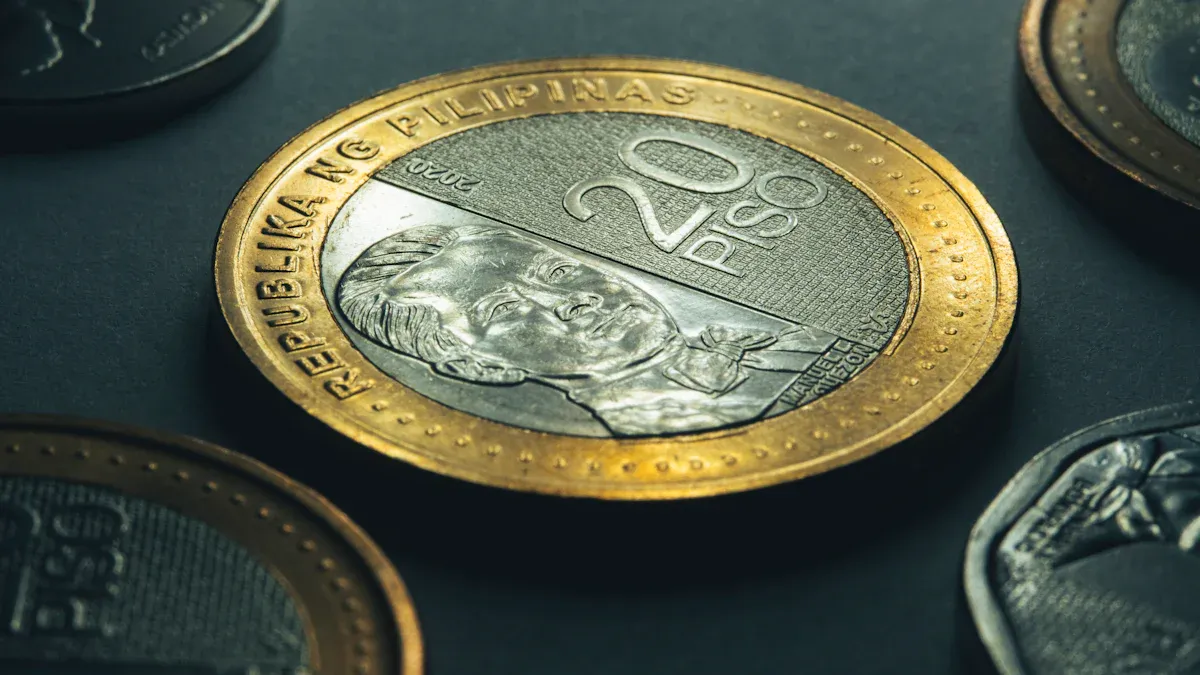
Image Source: pexels
Philippine peso coins have undergone various material changes throughout history. Early coins commonly used silver and copper, and as times progressed, materials shifted to nickel, copper, zinc, and steel. The evolution of coin materials reflects the nation’s economic conditions and technological advancements. For example, 18th-century coins were primarily made of high-purity silver, while copper or bronze was incorporated in the 19th century. The table below shows the main materials and their proportions in certain historical periods:
| Material | Proportion | Time Period |
|---|---|---|
| Silver | 27.07g (0.955 oz) | From 1726 (0.917 purity) |
| Silver | 27.07g (0.955 oz) | Revised in 1771 (0.903 purity) |
| Copper or Bronze | 20 cuartos = 1 real | 1837 (160 cuartos = 1 peso) |
Coins are not only tools for circulation but also carry the cultural symbols and historical memory of the nation.
Key Points
- The material of Philippine peso coins has transitioned from precious metals to nickel, copper, zinc, and steel, reflecting economic and technological progress.
- Coin designs are not only a representation of monetary function but also a symbol of national culture and history, enhancing national identity.
- Modern coins adopt new technologies, such as laser engraving, improving design aesthetics and security while reducing production costs.
- Changes in coins are closely tied to global metal price fluctuations, ensuring the stability and security of currency circulation.
- Collectors should focus on the material, year, and condition of coins, as limited-edition and commemorative coins typically have higher market value.
Material of Philippine Peso Coins
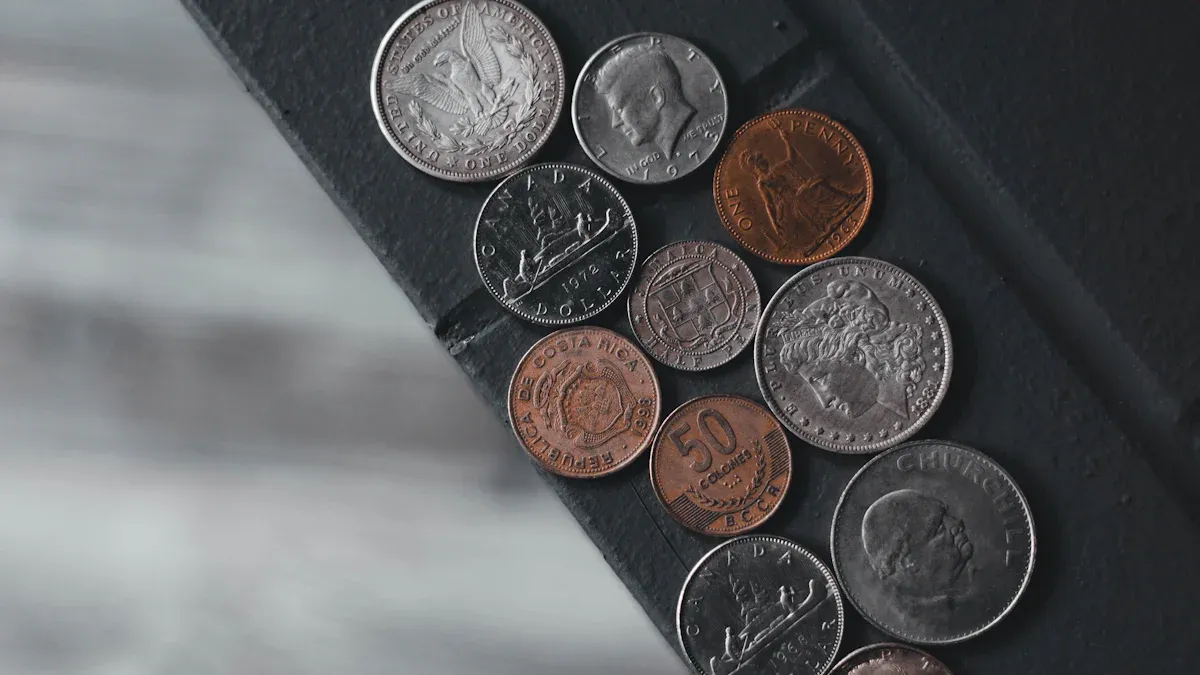
Image Source: pexels
Early Materials
The material of Philippine peso coins has undergone multiple transformations throughout history. Early coins primarily used gold and silver, which not only reflected the value of the currency but also showcased the economic strength of the time.
The table below shows the main materials and weights of Philippine peso coins in different periods:
| Year | Material | Weight (g) |
|---|---|---|
| 1861-1865 | Gold | 20 |
| 1903-1935 | Silver and Nickel | 26 |
| 1972-1975 | Nickel-Brass | 15 |
| 1975-1983 | Copper-Nickel Alloy | 9 |
| 1983-1991 | Copper-Nickel Alloy | 9.5 |
| 1991-1994 | Stainless Steel | 3 |
| 1995-2004 | Copper-Nickel Alloy | 6 |
| 2004-2018 | Nickel-Plated Steel | 5 |
| 2018-Present | Nickel-Plated Steel | 6 |
The use of gold and silver was heavily influenced by global metal price fluctuations. As metal prices rose, the metal value of some coins even exceeded their face value, leading people to melt coins for profit. The Bangko Sentral ng Pilipinas (BSP) thus adjusted coin compositions, reducing precious metal content to ensure currency circulation stability.
Modern Materials
In modern times, Philippine peso coins have gradually adopted more economical and durable materials. Nickel, copper, zinc, and steel have become mainstream choices. These materials not only reduce production costs but also enhance corrosion resistance.
Since 1991, stainless steel and nickel-plated steel have become the primary materials. The new generation currency series uses nickel-plated steel, effectively addressing discoloration issues in humid environments.
The bar chart below illustrates the weight changes of coins over different periods:
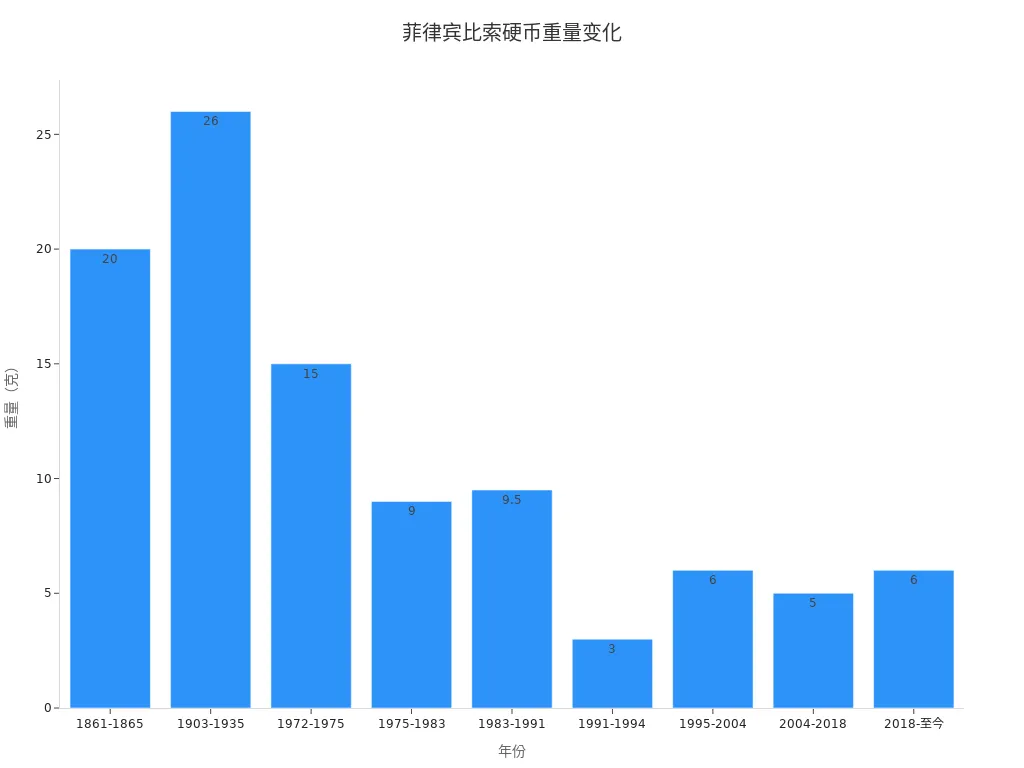
The material changes in Philippine peso coins are influenced not only by economic factors but also by global metal prices. The central bank adjusts coin compositions to prevent the metal value from exceeding the face value, ensuring the safety of the currency system.
Technological Advancements
In recent years, the manufacturing technology of Philippine peso coins has continuously advanced.
Key innovations include:
- The new generation of coins uses nickel-plated steel, significantly reducing production costs.
- Laser engraving technology is applied to micro-printing details on coins, enhancing design aesthetics and security, particularly evident in 10-peso and 5-peso coins.
- New materials effectively prevent illegal hoarding of coins for their metal content.
- Automated processing technology reduces the burden of manual operations, improving production efficiency.
- Coin recycling programs increase public participation, expected to save approximately USD 382,000 to USD 1.629 million in the first year.
- Through technological integration, operational processes are more efficient, benefiting banks and retailers in coin sorting and counting, reducing operational complexity and costs.
The table below summarizes the impact of technological innovations on coin production efficiency and costs:
| Evidence Point | Impact |
|---|---|
| Implementation of CoDMs | Improved efficiency and cost-effectiveness of Philippine peso coin production |
| Coin Recycling Program | Estimated cost savings of USD 382,000 to USD 1.629 million in the first year |
| Automated Processing | Reduced demand for new coins, lowering minting costs |
The continuous upgrading of materials and manufacturing technologies for Philippine peso coins reflects the nation’s focus on economic efficiency and currency security. These changes not only mirror economic development but also demonstrate the profound impact of technological progress on the currency system.
Design History
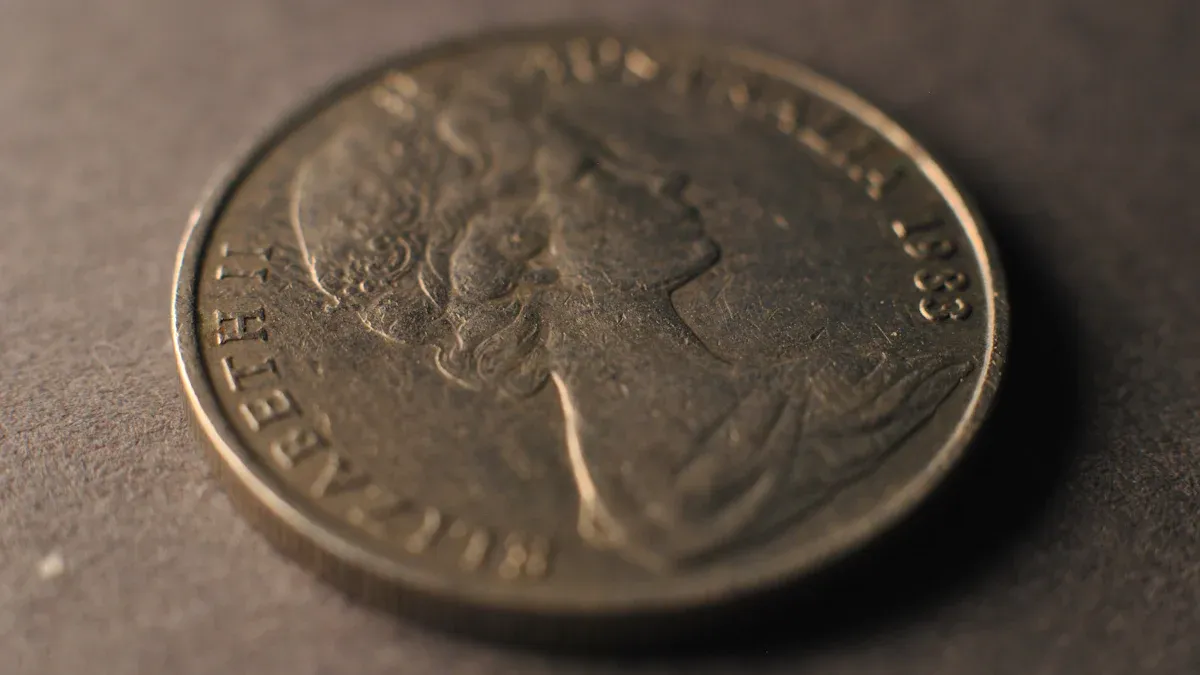
Image Source: unsplash
Evolution of Philippine Peso Coin Designs
The design of Philippine peso coins has undergone several significant changes. Designs not only reflect the aesthetics of the era but also embody shifts in national identity. In 1947, the Philippines issued its first commemorative coin, featuring a portrait of Douglas MacArthur on the obverse and the national seal on the reverse. From 1958 to 1963, coins used English inscriptions, known as the English series. In 1967, the central bank introduced images of national heroes and used Tagalog, strengthening national identity. In 1975, the “New Society” series was launched, introducing the 5-peso coin. In 2017, the central bank released the new generation currency series, with the first coin featuring Andres Bonifacio to commemorate his 154th birth anniversary. In 2018, the new generation currency series was fully released, with a 20-peso bimetallic coin added in 2019.
| Year | Design Features | Notes |
|---|---|---|
| 1947 | Commemorative silver coin for Douglas MacArthur, with his portrait on the obverse and the national seal on the reverse. | Only a limited number of commemorative coins were issued. |
| 1958-1963 | Used diameters equivalent to U.S. coins, retaining early designs and English inscriptions. | Known as the English series. |
| 1967 | Introduced images of Philippine national heroes and used Tagalog. | Known as the Pilipino series. |
| 1975 | Issued the “New Society” series, adding the 5-peso coin and discontinuing the 50-centavo coin. | Produced by multiple mints. |
| 2017 | Released the new generation currency series, with the first 5-peso coin featuring Andres Bonifacio. | Commemorated Bonifacio’s 154th birth anniversary. |
| 2018 | Completed the release of the new generation currency series, including 1, 5, 25 centavos, and 1, 10 peso coins. | The 20-peso coin was added in 2019. |
The trend of coin design series changes over the years is shown in the chart below:
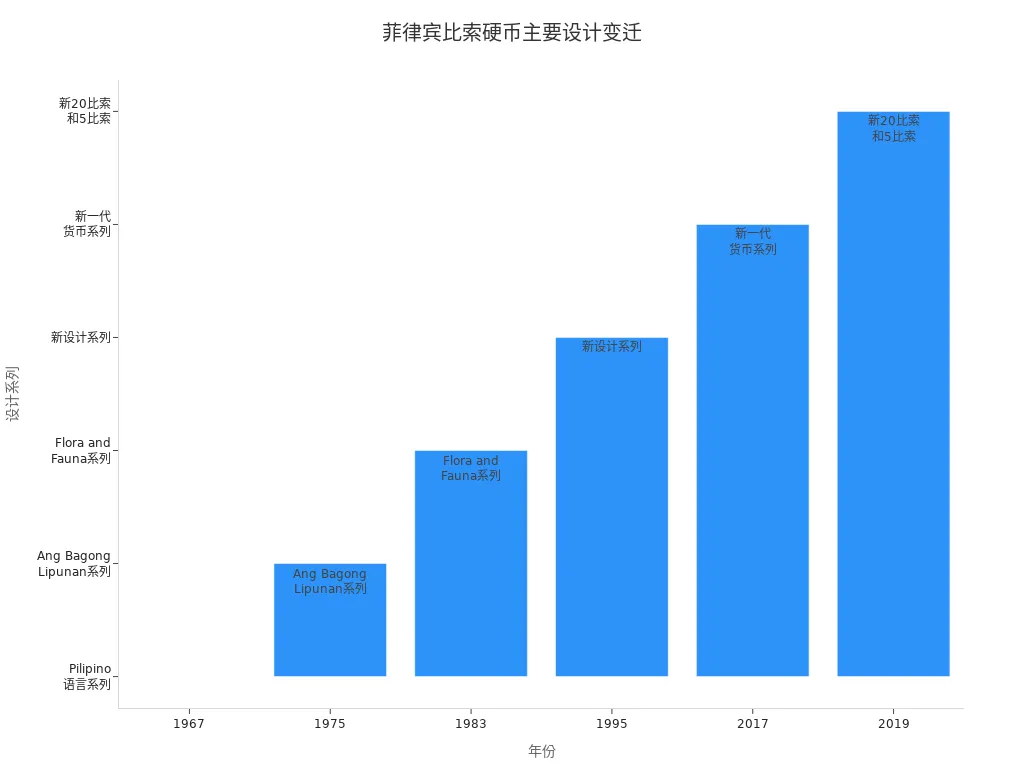
Cultural Symbols
The patterns on Philippine peso coins are not merely decorative but also symbols of national culture. Designers often select national heroes, historical figures, and natural landscapes as the main elements for the obverse and reverse of coins. For example, portraits of the Aquinos, Jose Rizal, and other national heroes frequently appear on coins, highlighting national pride. The new generation currency series also incorporates the Philippines’ natural landscapes, such as rare flora and fauna and landmark buildings, reflecting the nation’s emphasis on its natural heritage.
The newly designed coins feature Philippine national symbols, reflecting the country’s cultural heritage and achievements. These designs are not only functional for currency but also carry the nation’s history and culture, promoting national identity.
The table below shows the changes in major design series and materials:
| Year | Design Series | Material |
|---|---|---|
| 1967 | Pilipino Language Series | Aluminum 1 centavo, brass 5 centavos, nickel-brass 10, 25, and 50 centavos |
| 1975 | Ang Bagong Lipunan Series | Aluminum 1 centavo, brass 5 centavos, copper-nickel 10, 25 centavos, and 1 peso, pure nickel 5 pesos |
| 1983 | Flora and Fauna Series | Aluminum 1, 5, and 10 centavos, brass 25 centavos, copper-nickel 50 centavos, 1 peso, and new 2 pesos |
| 1995 | New Design Series | Copper-plated steel 1, 5, and 10 centavos, brass 25 centavos, copper-nickel 1 peso, and nickel-brass 5 pesos |
| 2017 | New Generation Currency Series | Nickel-plated steel 1, 5, 25 centavos, and 1, 5, 10 pesos |
| 2019 | New 20-peso and revised nonagonal 5-peso | Bimetallic plated steel 20 pesos and revised 5 pesos |
The Bangko Sentral ng Pilipinas has continuously strengthened national identity in coin designs. Starting in 1967, the central bank began using Filipino language on the banknote series, marking a reinforcement of national identity. The Pilipino series banknotes launched in 1969 showcased significant Philippine historical figures and events, promoting national unity. In 2009, the central bank announced a major redesign of banknotes and coins, featuring prominent Filipinos and natural landscapes, further enhancing national pride.
Historical Events
Philippine peso coins are often used to commemorate significant national historical events. Designers record pivotal moments in the Philippines through coins. For example, a coin issued in 1992 commemorated the 50th anniversary of the Bataan campaign, a coin issued in 2011 commemorated Jose Rizal’s 150th birth anniversary, and a coin in 2017 marked the 50th anniversary of ASEAN’s establishment. These commemorative coins not only have collectible value but also help the public remember history.
| Commemorative Event | Year | Description |
|---|---|---|
| 50th Anniversary of Bataan Campaign | 1992 | This coin design commemorated the 50th anniversary of the Bataan campaign. |
| Jose Rizal’s 150th Anniversary | 2011 | This coin was minted to commemorate the 150th birth anniversary of national hero Jose Rizal. |
| ASEAN 50th Anniversary | 2017 | This coin design commemorated the 50th anniversary of ASEAN’s establishment and was related to the Philippines hosting the ASEAN Summit. |
The design of Philippine peso coins not only witnesses the nation’s historical changes but also serves as a symbol of national unity and cultural confidence. The central bank strengthens national identity and raises public awareness of history through continuous design innovation.
Economic and Social Change
Economic Impact
The material and design changes of Philippine peso coins directly reflect the nation’s economic conditions. Each material adjustment is related to global metal price fluctuations and domestic economic policies. The stability and wide acceptance of the peso have facilitated trade and economic activities, serving as a cornerstone of the domestic economy.
- The fluctuations of the Philippine peso reflect the nation’s economic health, demonstrating its adaptability to global financial challenges.
- The peso symbolizes the spirit and resilience of the Filipino nation, reflecting their commitment to progress amid economic turbulence.
During financial crises, Philippine peso coins demonstrated economic resilience. The central bank ensured the security of the currency system by adjusting coin compositions, boosting public confidence in the economy.
Social Symbolism
Coins are not only transactional tools but also symbols of social change. The new generation of Philippine peso coin designs highlight national heroes, unique flora, and cultural significance, enhancing public pride and national awareness. The Coin-Ed program emphasizes improvements in new coin designs, reflecting national identity and pride.
The table below shows some coins commemorating social movements and historical events:
| Denomination | Commemorative Event |
|---|---|
| 100 Pesos | Commemorates the 1898 Philippine Declaration of Independence |
| 20 Pesos | Commemorates the establishment of the First Philippine Republic at Barasoain Church |
| 5 Pesos | Commemorates Filipinos who sacrificed in the Philippine-American War |
These designs make coins a testament to national unity and social change.
Collectible Value
Philippine peso coins hold collectible value due to their material, design, and historical significance. Collectors prefer limited-edition and commemorative coins, which are often made of precious metals, have unique designs, and carry higher market value than regular circulation coins.
The table below compares the market value of commemorative and circulation coins:
| Evidence Type | Description |
|---|---|
| Commemorative Coins | Unique designs with historical significance, often made of precious metals, thus higher in value. |
| Circulation Coins | Regular circulation coins, typically without special designs or materials. |
The collectible prices of some coins are as follows:
| Coin Name | Year | Material | Condition | Price (USD) |
|---|---|---|---|---|
| Peso | 1961 | Silver | EF(40-45) | 38 |
| 10 Piso | 2006 | Bimetallic | MS(65-70) | 9.95 |
| 10 Centavos | 1944 | Silver | EF(40-45) | 9.95 |
| 20 Centavos | 1945 | Silver | EF(40-45) | 10 |
| Alfonso XII - 50 Centimos | 1885 | Silver | AU(50-53) | 73.95 |
| 20 Centavos | 1944 | Silver | AU(50-53) | 14 |
| Peso | 1964 | Silver | AU(50-53) | 35 |
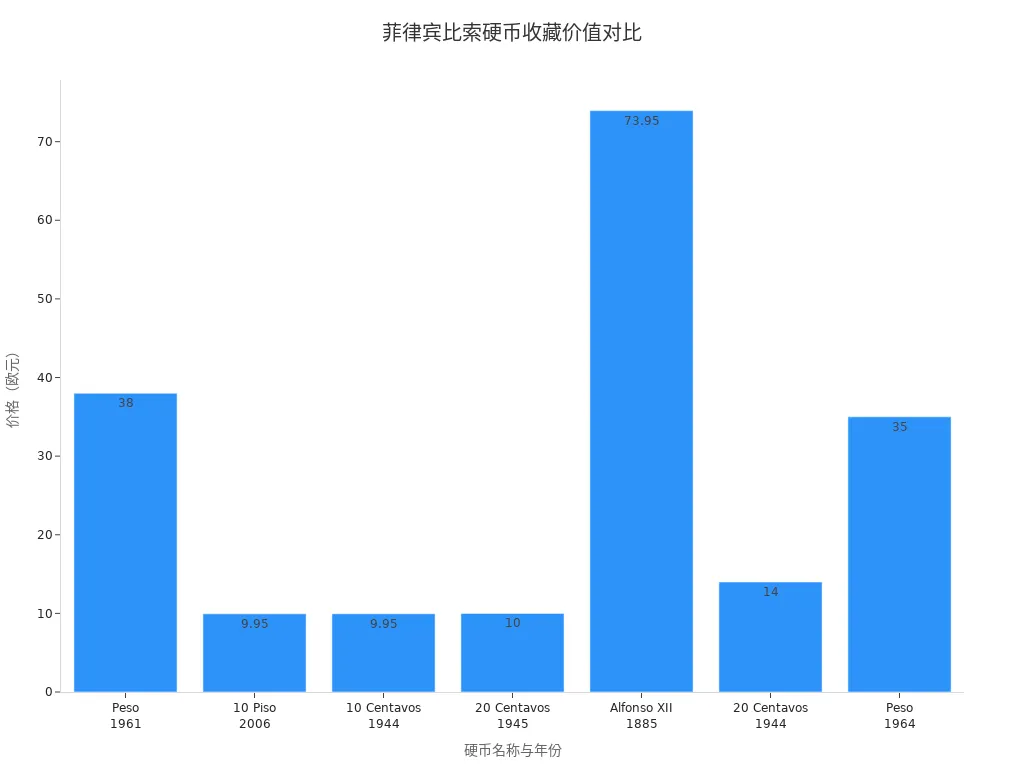
Philippine peso coins not only witness economic and social changes but also serve as historical symbols pursued by collectors.
Philippine peso coins are more than just circulating currency. They reflect the socio-political context of different eras, witnessing the evolution of Filipino identity. The materials and designs of coins showcase the nation’s cultural and economic development. Studies show that coins carry rich historical and cultural significance. By observing these coins, people can gain a deeper understanding of the Philippines’ diverse culture and economic changes.
FAQ
Can Philippine peso coins be exchanged in mainland China?
Banks in mainland China generally do not directly exchange Philippine peso coins. Some counters at licensed banks in Hong Kong may offer exchange services, settled in USD. It’s recommended to check bank policies in advance.
Reminder: Coin exchange services are limited; prioritize exchanging banknotes.
How is the collectible value of Philippine peso coins determined?
Collectors primarily judge value based on the coin’s issuance year, material, condition, and historical significance. Commemorative and limited-edition coins typically have higher value. Market prices are quoted in USD.
| Influencing Factor | Description |
|---|---|
| Material | Precious metals are more popular |
| Year | Earlier coins are rarer |
| Condition | Well-preserved coins are more valuable |
Why do Philippine peso coin designs change frequently?
Design changes reflect the nation’s history, culture, and economic development. The central bank reinforces national identity and commemorates significant events through new designs. Design changes also enhance anti-counterfeiting capabilities.
Are Philippine peso coins circulated in the U.S. market?
Philippine peso coins are not circulated in the U.S. market. Tourists can exchange pesos for USD at certain exchange points. U.S. banks do not accept peso coins for deposits or withdrawals.
What are the main materials of Philippine peso coins?
Modern Philippine peso coins primarily use nickel-plated steel, copper-nickel alloy, and stainless steel. Early coins mostly used silver and gold. Material changes are closely tied to economic and technological progress.
From the gleaming silver coins of the 18th century to today’s durable nickel-plated steel, the evolution of the Philippine peso is not just a chronicle of metals, but a condensed national narrative. Each shift in material reflects the pulse of the economy and the march of technological progress; every design update carries reverence for national heroes and appreciation for natural heritage. These coins are more than currency—they are mobile cultural symbols, silently narrating the Philippines’ past, present, and future.
Yet, for Filipinos abroad or those engaged in business with the Philippines, understanding coin history is important, but the more pressing need is how to send funds efficiently and cost-effectively. Traditional remittance methods often come with high fees and opaque exchange rates.
BiyaPay offers a smarter solution. We provide highly competitive fees (as low as 0.5%) and same-day fund availability—send and receive on the same day, while ensuring every transaction is transparent… You can use our real-time exchange rate calculator to precisely understand the actual cost of every transaction, eliminating the worry of hidden charges. After sending money, you can directly invest in stocks on the same platform—no need for complex account setups—making it easy to participate in global markets and grow your wealth.
Choosing BiyaPay means your remittance is not just about transferring money, but about delivering peace of mind and value. Sign up at BiyaPay today and experience faster, more transparent cross-border financial services, making it easy for your funds to cross borders and arrive with ease.
*This article is provided for general information purposes and does not constitute legal, tax or other professional advice from BiyaPay or its subsidiaries and its affiliates, and it is not intended as a substitute for obtaining advice from a financial advisor or any other professional.
We make no representations, warranties or warranties, express or implied, as to the accuracy, completeness or timeliness of the contents of this publication.




Contact Us
Company and Team
BiyaPay Products
Customer Services
is a broker-dealer registered with the U.S. Securities and Exchange Commission (SEC) (No.: 802-127417), member of the Financial Industry Regulatory Authority (FINRA) (CRD: 325027), member of the Securities Investor Protection Corporation (SIPC), and regulated by FINRA and SEC.
registered with the US Financial Crimes Enforcement Network (FinCEN), as a Money Services Business (MSB), registration number: 31000218637349, and regulated by FinCEN.
registered as Financial Service Provider (FSP number: FSP1007221) in New Zealand, and is a member of the Financial Dispute Resolution Scheme, a New Zealand independent dispute resolution service provider.



















